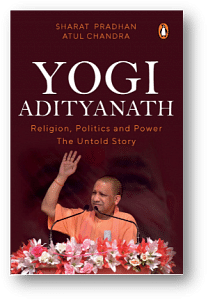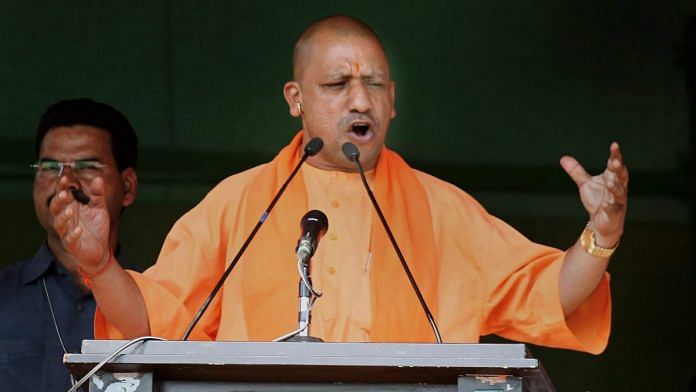As it appeared from his public life, whether rightly or wrongly, Adityanath’s mindset is simple and straight—whatever is required in the interest of the country has to be done, and done with commitment. The bitter pill, if required, has to be administered without any sugar coating. A clear pointer of things to come as majoritarian politics gained currency in the state.
The February 2017 television interview also made clear that Adityanath does not view Mughal monuments as part of India’s virasat (heritage); even renaming Taj Mahal as Tejo Mahalay is not beyond him, though he says he would like the issue to be debated.
Speaking at Vishwa Hindu Parishad’s (VHP’s) Virat Hindu Sammelan on 25 February 2015 in Rohtak, Adityanath said, ‘Conversions spoil communal amity in the country. [They] should be banned. If conversions continue, I feel Ghar Vapasi programme will continue.’
He also alleged that ‘anti-national activities breed’ in ‘Muslim areas’ and that ‘secularists’ should answer his questions. ‘India’s problem is not malnutrition or poverty. India’s problem is vote bank politics fuelled by jehadi fervour. In Hindu society everyone feels safe, every mother and sister feels safe. There is guarantee of safety of each and every religious sect here.’
Prior to being anointed as chief minister, Adityanath faced three criminal cases. While two of these were filed in January 2007 for allegedly inciting violence and making communal speeches, the third one was filed way back in 1999, accusing him of ‘murder, criminal intimidation, trespassing on burial spaces, destroying/defiling any place of worship’. However, he got relief in each one of them, after he was installed as chief minister.
Yogi Adityanath was known for his love–hate relationship with the BJP leadership. He established himself as an independent power centre with a distinct form of Hindutva. His strong communal statements and tall demands for his HYV during the election campaign did give anxious moments to the BJP leadership. Yet, the BJP and RSS leadership hoped to ‘contain and control’ Adityanath by appointing him to the most sought- after political office of Uttar Pradesh, while simultaneously using him to consolidate their Hindutva hold over the rising, upwardly mobile, non-Brahmin elite. Ever since he became chief minister, Yogi Adityanath has been busy trying to give the impression that ‘communal’ charges were falsely slapped on him, when he actually never indulged in any kind of hate speech.
Also read: BJP’s ‘double-engine’ pitch sells development but UP still lagging. See these indicators
In an exclusive interview given to the authors at the chief minister’s official residence in Lucknow in October 2017, Yogi Adityanath sought to make the media his punching bag. Asked to comment on his widely perceived ‘communal’ agenda and the tendency to give everything a Hindu–Muslim colour, he did not mince words in pointedly accusing the media of painting him black. ‘The media has its own bias and mindset against me and therefore it tends to always depict me in negative light’, was his charge. As a counter-question, he asked: ‘I would like to know what you understand of secularism? Can there be a more secular nation than India, where people of all castes, creed or faith have lived together for centuries?’
He was, however, caught on the wrong foot when his attention was drawn to his speech on Nepal, where he expressed his displeasure about the new Nepali dispensation favouring secular and democratic values. He said, ‘my views were twisted in the media.’ He added, ‘Please view what I said in the context in which I spoke. What the media does is to skip the context and give out half-truths in order to project me in poor light. If you make it a point to view my remarks in a particular context, you will never find me wrong.’
Also read: Yogi’s cows, Modi’s houses, Akhilesh’s jobs: Why this is a more ‘normal’ Uttar Pradesh election
That secularism is not his cup of tea has been expressed quite explicitly by Adityanath in his article penned under the headline, ‘Antar-raashtreey saazishon ke jaal me phansta Himalayee Rashtra Nepal’ (Nepal getting caught in international conspiracies), which is part of the dissertation ‘Hindu Rashtra Nepal: Ateet aur Vartman’ (Hindu Rashtra Nepal: Past and Present). Describing 18 May 2006 as a ‘Black Day’, when the country’s kangaroo parliament passed an ‘unfortunate and unexpected’ resolution declaring Nepal a secular state, Adityanath squarely blames Maoists, Islamic militants and Christians for the ‘unconstitutional’ decision.
He expressed the same sentiment when he was asked whether he had altered the course of the philosophy of Gorakhnath who did not believe in hardcore sanatan dharma—a practice now being aggressively advocated by Adityanath.
You have again got it wrong. I cannot imagine that an educated man like you would not know what sanatan dharma is. If Gorakhnath did not believe in ‘sanatan dharma’, then tell me, what did he believe in? What he practised and preached was sanatan dharma only and that is a Hindu practice which has been going on for ages. Where is the conflict and where is the question of any deviation from Baba Gorakhnath’s philosophy? I am only carrying on his spiritual legacy. Here again, you need to look at his teachings in the wider perspective then you will understand that whatever he did and preached was no different from sanatan dharma. After all, it began with the worship of ‘shakti’—something that Lord Shiva too believed in. There is absolutely no difference.
While asserting that he had not deviated from the line laid down by Gorakhnath, whose philosophy was deeply rooted in secularism, he sought to know:
Where has the secular fabric of this organization been violated? Many jogis were traditionally used to moving from place to place. They did not necessarily make the Gorakhnath temple their home. Therefore, it was natural for them to be shifting base with the passage of time. They used to sing bhajans also. And no one is denying them entry to the temple even now. You are making a false allegation if you seem to think that I have driven them away. Why should I?
Also read: Mahants and maths: Adityanath’s religious lineage that will shape 2022 UP election
Adityanath went on to add:
Haven’t you seen how so many Muslims come to my janata durbar at the Gorakhnath temple every day, whether I am there or not? And you can check for yourself that there is no discrimination of any kind with them. Their problems are dealt with just the same attention and commitment as that of any Hindu. The trouble with the media is that they are always looking at me with their own coloured vision.20
Instantly, he reverted to his familiar territory of minority bashing, accusing them of being responsible for India—a ‘Sanatanee’ Hindu state since time immemorial—not becoming a Hindu Rashtra. ‘But for the “scheming” Muslims and Christians, India would have become a Hindu state,’ was his prognosis.
Fact remains that several commercial establishments within the premises of the Gorakhnath temple are being run by Muslims and a few of the temple employees also belong to the minority community. And that is surprising to many.
At the end of the day, there could be no denying this sadhu-turned-politician has made it big, not by dint of any merit but by using religion and playing the politics of hardcore polarization. Having created his own political space at the highest level in the state, Adityanath is now aspiring for a bigger role in national politics—using the same tools.
 This excerpt from ‘Yogi Adityanath: Religion, Politics and Power, The Untold Story’ by Sharat Pradhan and Atul Chandra has been published with permission from Penguin Random House India.
This excerpt from ‘Yogi Adityanath: Religion, Politics and Power, The Untold Story’ by Sharat Pradhan and Atul Chandra has been published with permission from Penguin Random House India.






